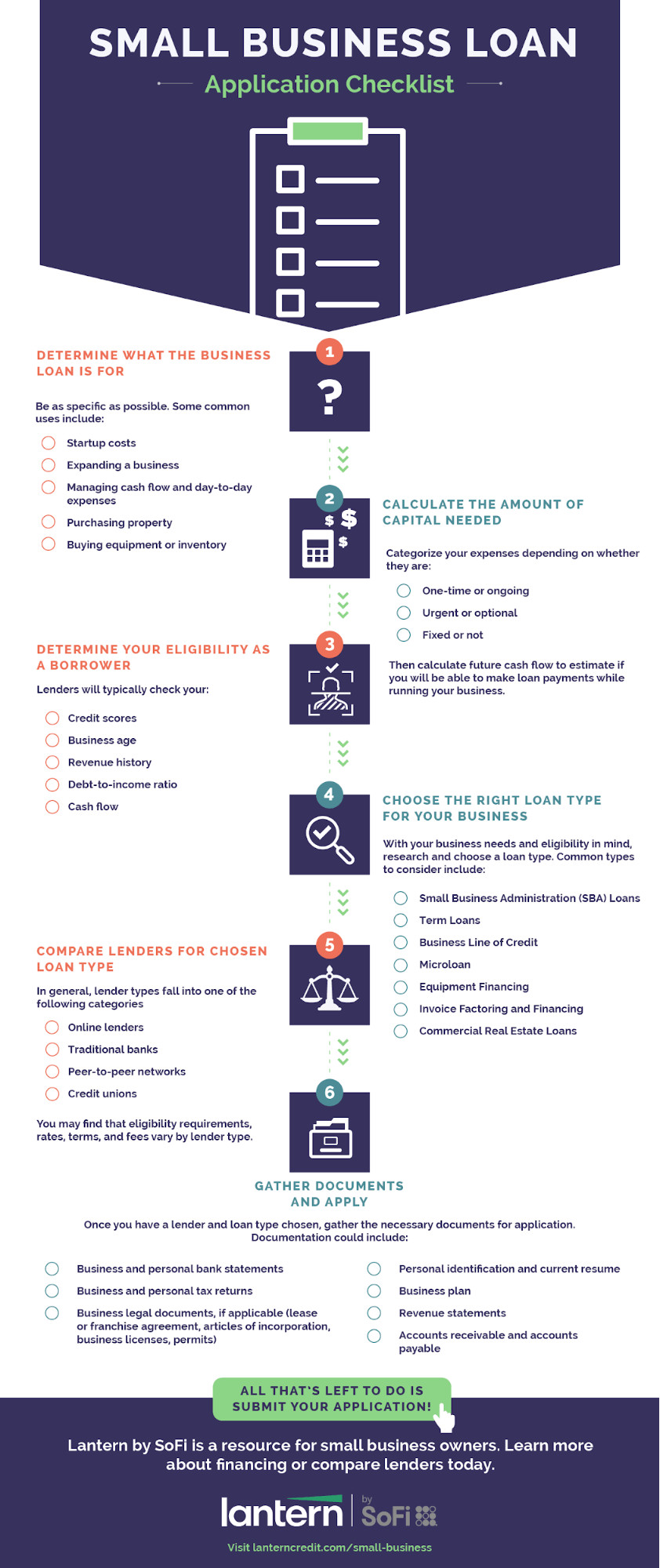7 Step Guide to Getting a Small Business Loan

Share this article:
Editor’s note: Lantern by SoFi seeks to provide content that is objective, independent and accurate. Writers are separate from our business operation and do not receive direct compensation from advertisers or partners. Read more about our Editorial Guidelines and How We Make Money.
1. Determine Why You Need a Small Business Loan
Upfront costs Expanding a business Managing cash flow Purchasing property Buying equipment or inventory
Upfront Business Costs
Rent, utilities, and property repairs Inventory Equipment Marketing Insurance Payroll Permits Legal fees
Expanding Your Business
Managing Cash Flow
Purchasing Property
Buying Equipment and Inventory
2. Review the Business Loan Requirements
Credit scores Business age Revenue history Debt-to-income ratio Cash flow
Lenders Want to Know Your Credit History and Score
Building Business Credit
Separate your business from your personal finances by getting an Employer Identification Number (EIN) and maintaining a business bank account that is separate from your personal account. Open a business credit card or business line of credit and make payments on time. Work with vendors and suppliers who report to business credit bureaus. Check your personal and business credit reports.
Is Your Business Established?
Revenue History Matters
Knowing Your Debt-to-Income Ratio (DTI)
Is Your Cash Flow Sufficient?
3. Calculate the Amount of Capital Needed
One-time purchases or ongoing: One-time major purchases can disrupt cash flow. Ongoing expenses happen monthly, quarterly, or annually and don’t change much. Essential or optional: Can the business operate without this purchase? If not, it's essential. If so, it's optional. Essential expenses are typically prioritized over optional ones. Fixed expenses: Fixed expenses don’t change significantly or often. These may include rent, insurance, or regular business expenses. Consider what your business loan may need to cover and adjust your desired amount accordingly.
Estimating Cash Flow
4. Choose the Right Loan for Your Small Business
Small Business Administration (SBA) Loans
Why Choose an SBA Loan?
Things to Keep in Mind About SBA Loans
Term Loans
Why Choose Term Loans?
Things to Keep in Mind About Term Loans
Business Line of Credit
Why Choose a Business Line of Credit?
Things to Keep in Mind About Business Lines of Credit
Microloan
Why Choose a Microloan?
Things to Keep in Mind About Microloans
Equipment Financing
Why Choose Equipment Financing?
Things to Keep in Mind About Equipment Financing
Invoice Factoring and Financing
Why Choose Invoice Factoring and Financing?
Things to Keep in Mind About Invoice Factoring and Financing
Commercial Real Estate Loans
Why Choose Commercial Real Estate Loans?
Things to Keep in Mind About Commercial Real Estate Loans
5. Compare Types of Lenders for Small Business Loans
Online Lenders
Fast application review Quick access to funds Can be easier to qualify for with little business credit or history Easy to compare different lenders Options for unsecured loans
Traditional Banks
Peer-to-Peer (P2P) Lending Networks
Credit Union
6. Gather Documents
Business and personal bank statements Business and personal tax returns Business legal documents Personal identification and resume Business plan Revenue statements Accounts receivable and payable
Small Business Loan Application Checklist

7. The Application Process
Applying
What to Expect After Applying
What Happens When You Get Your Loan
The Takeaway
Frequently Asked Questions
LCSB0923004
About the Author
Lantern is a product comparison site that makes it easy for individuals to shop for products and compare offers with top lenders. Lantern is owned and operated by SoFi Lending Corp., the digital personal finance company that has helped over one million people get their money right.
Share this article: